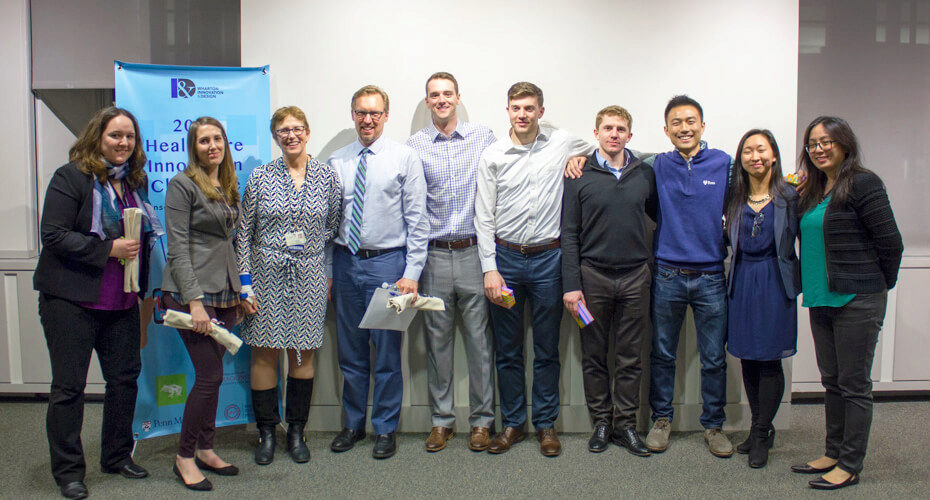
Competition judges Elissa Klinger, Melissa Brown, Dr. Susan Day, Todd Kirkes, and Gloria Chow with winners John Tiernan, William Fix, Daniel O’Brien, Tianze Chris Yi, and Julia Lin.
For many of us, managing our health care or those of our loved ones can be a challenge.
Many hospitals are now launching online patient portals to reduce some of the stress that comes hand-in-hand with our health care management. Penn Medicine’s online patient portal is called myPennMedicine (MPM) and through MPM, patients have access to their personalized care information (e.g., medical records, prescriptions, bills, secure messaging with providers, etc.) at their fingertips. With MPM facilitating the care experience, patients can now focus on what’s most important: their health.
However, new technology solutions bring new challenges along with their benefits and PennMed is constantly looking to improve the adoption and engagement of MPM.
In the 2018 Healthcare Innovation Challenge, students across Penn’s graduate schools, including the Wharton School, Integrated Product Design program, Perelman School of Medicine, School of Nursing, School of Design, School of Engineering and Applied Science, and Fels Institute of Government, came together to tackle this patient engagement challenge.
For the Healthcare Innovation Challenge, the Wharton Innovation & Design Club partnered with Penn Medicine’s Center for Health Care Innovation and frog, a global design and innovation consultancy, to bring this collaborative competition to life. The program was sponsored by Penn Medicine, the Mack Institute, Wharton Digital Health Club, and the Penn Graduate and Professional Student Assembly (GAPSA).
Over the course of three intensive weeks, students assigned to interdisciplinary teams employed design thinking methodologies to create user-centric solutions for the patients of PennMed. To guide participants in researching and building their solutions, frog led two workshops focused on ethnographic research, insight generation, and rapid prototyping and testing.
“It is inspiring to see PennMed tackle real, patient health challenges through the design process, taking advantage of incredible interdisciplinary Penn talent,” said Linda Quarles, frog’s Director of Organizational Design. “We look forward to seeing the winning ideas be implemented to drive better patient engagement and ultimately health and wellness.”
On February 19, 2018, eleven teams presented their findings and solutions to a judging panel that included an internal medicine physician, a frog strategist, the assistant director of the Center for Digital Health, and leaders from the health system’s electronic health record integration team.
The winning team’s solution included a focus on the clinician-patient messaging aspect of MPM. Currently, the messaging feature often leads to an excess of messages that clinicians must sift through and prioritize. The winning team proposed features such as structuring patient messages into specific categories. Their design interface allows for clear prioritization through its guided communication between patient and provider, making it faster and easier for clinicians to respond to patients.
The team shared their thoughts about what they found to be the most valuable aspect of the Healthcare Innovation Challenge:
Julia Lin, a first-year master’s student in Integrated Product Design, said, “The access to PennMed and design research professionals gave us the opportunity to develop, prototype, and test solutions grounded in patients’ real experience. Talking to the clinic let us visualize how our solution would fit into existing patient and provider workflows, and then develop a feasible idea.”
“To me, the most valuable aspect is the iterative design thinking,” added Tianze Chris Yi, a first-year Bioengineering master’s student. “I learned the value of defining the problem, ideating, and prototyping. More importantly, I learned about the importance of listening to the end users of a product. First-hand accounts from patients and physicians gave me fresh perspectives on how to improve electronic medical records.”
Looking forward to 2019, the team also shared some advice and best practices from which a future team would benefit:
John Tiernan (WG’19) advised, “Conduct as much user research as possible. Meet with different user groups to understand overlapping areas of interest or points of frustration.”
William Fix, an upcoming fourth-year MD candidate, added, “As a team we tried to understand the incentives behind the push for changes to myPennMedicine. By starting at the very beginning and asking “Why?” I think we were able to come up with a more meaningful question and solution.”



